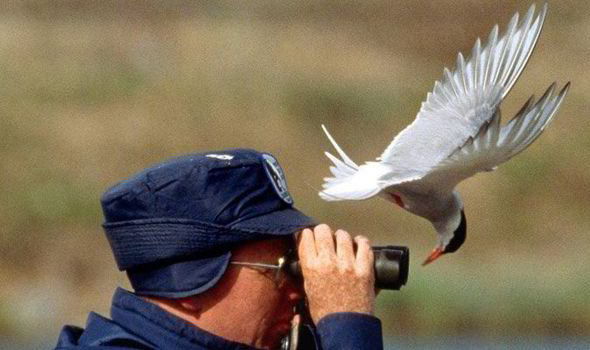Bottom line, regardless of the reason, anytime people head outdoors to look for and appreciate nature, it’s a good thing. The social-distancing required to fight the worldwide pandemic over these past 11 months has led to significant increases in the time people are spending outdoors–hiking, nature-watching, and exploring. The use of websites and apps that support observing nature is also way up. All indications are that many people are reconnecting with their natural roots and have no intention of cutting back once coronavirus restrictions are lifted.

While that’s very positive news overall, those of us in the birding community, in particular, are aware of an associated trend that is slightly concerning, as well. The cataloguing capabilities of sites such as eBird, iNaturalist, HerpMapper, the wildlab, and many more are great motivators for connecting citizens with the natural world around them; for a small minority of people, however, the technological ease with which one can list and post sightings can play into competitive urges and even  obsessions. Extreme British birders have long been called ‘twitchers,’ a term that until recently was hardly applicable to most American nature enthusiasts. However, recently many of us have noticed a growing trend toward listing at all costs; both the nature-watchers who fall into this trap and the wildlife that they are determined to document pay a price. Those driven by the ‘need’ to continually add new species to their life lists, state lists, county lists, year lists, cloudy-Tuesday-afternoon lists, sometimes become blinded by this goal. They enter private property without permission, sneak into parks before or after hours, approach so close in order to get the ‘perfect photo’ and
obsessions. Extreme British birders have long been called ‘twitchers,’ a term that until recently was hardly applicable to most American nature enthusiasts. However, recently many of us have noticed a growing trend toward listing at all costs; both the nature-watchers who fall into this trap and the wildlife that they are determined to document pay a price. Those driven by the ‘need’ to continually add new species to their life lists, state lists, county lists, year lists, cloudy-Tuesday-afternoon lists, sometimes become blinded by this goal. They enter private property without permission, sneak into parks before or after hours, approach so close in order to get the ‘perfect photo’ and  disturb the very animals they are seeking. On another level, they profess to be environmentalists, yet frequently drive hundreds of miles in search of new additions to their lists, without giving a thought as to the fossil fuels they’re burning and what they’re contributing to air pollution and climate change. Far less damaging, but particularly sad, is that they lose interest in more common species and only head out in search of rarities; in other words, they become driven by ‘the list’ and not by a real appreciation of nature.
disturb the very animals they are seeking. On another level, they profess to be environmentalists, yet frequently drive hundreds of miles in search of new additions to their lists, without giving a thought as to the fossil fuels they’re burning and what they’re contributing to air pollution and climate change. Far less damaging, but particularly sad, is that they lose interest in more common species and only head out in search of rarities; in other words, they become driven by ‘the list’ and not by a real appreciation of nature.
I won’t lie; on occasion, I have been known to drive half an hour in response to a report of something I’ve never encountered in the wild. If they were being truthful, I suspect most avid nature-types would admit to the same. It’s on your ‘target list,’ it would be new and cool to see, and you know it’s been observed recently not too far away; why not go check it out? But, that’s not my normal M.O. The vast majority of my time outdoors is spent within a few miles of  my home or my beautiful workplace at Irvine. And, while new encounters of rarities certainly are special, they’re just icing on the cake. I have always taken great pleasure in observing critters that are common–even abundant–right here in the Maryland Piedmont and still get excited about seeing unfamiliar behaviors, unusual interactions between organisms, dramatic fluctuations in numbers, and new aspects of the natural history of wildlife that I see every day. Sure, people are going to flock to see a spectacularly-hued male Painted Bunting in Maryland–400-500 miles beyond the normal limits of its range. However, if after seeing it, while walking back to the car, one ignores the pair of local Indigo Buntings feeding their young right by the roadside, something has been lost. Nature appreciation does not require novelty; beauty exists in the familiar and should never be taken for granted.
my home or my beautiful workplace at Irvine. And, while new encounters of rarities certainly are special, they’re just icing on the cake. I have always taken great pleasure in observing critters that are common–even abundant–right here in the Maryland Piedmont and still get excited about seeing unfamiliar behaviors, unusual interactions between organisms, dramatic fluctuations in numbers, and new aspects of the natural history of wildlife that I see every day. Sure, people are going to flock to see a spectacularly-hued male Painted Bunting in Maryland–400-500 miles beyond the normal limits of its range. However, if after seeing it, while walking back to the car, one ignores the pair of local Indigo Buntings feeding their young right by the roadside, something has been lost. Nature appreciation does not require novelty; beauty exists in the familiar and should never be taken for granted.
On that note, I’d like to share three recent encounters I’ve had right here, in the Baltimore vicinity, this winter. All involve very common species that are so prevalent in our County that we often tune them out. However, in each of these cases, something unusual, something unique, caught my eye and made me stop, take note, and want to learn just a little bit more.
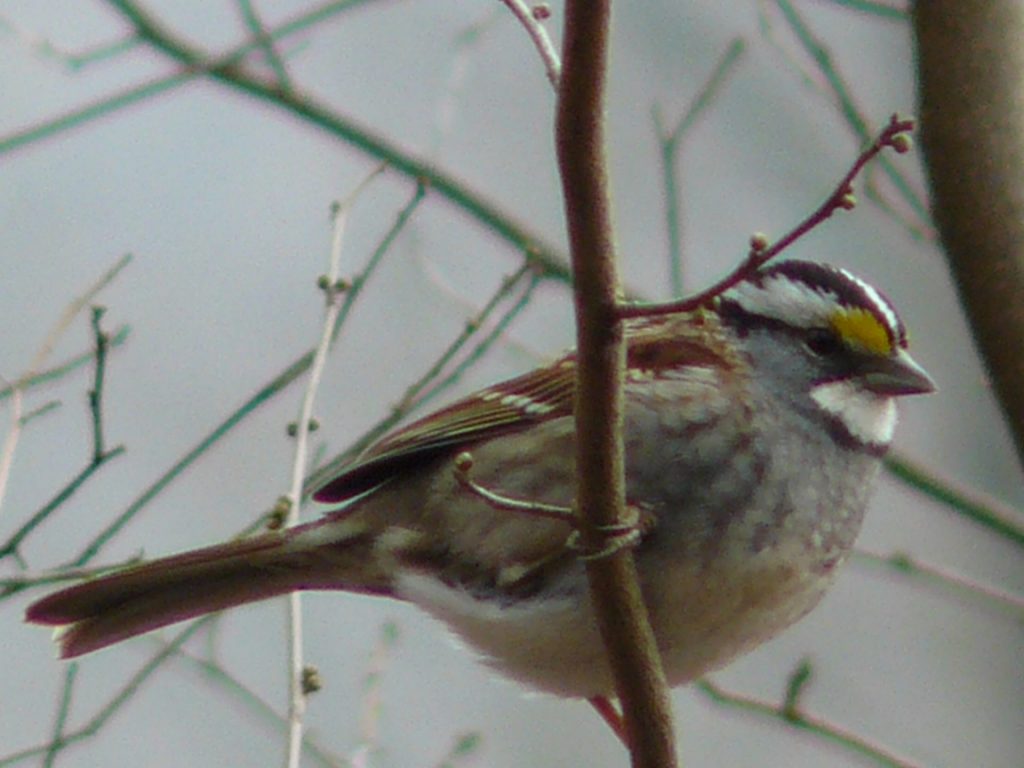
(1) Leucistic White-throated Sparrow:
Several weeks ago, while my car was in the shop getting an oil change, I walked about a mile to County Home Park, behind the Cockeysville Public Library. A relatively modest property which backs to the Fox Hollow Golf Course, the park is known as the home of the Historical Society of Baltimore County and a nice place to play tennis or pickleball, but it’s nothing special when it comes to seeking wildlife. There are a few very small ponds, which occasionally bring in some dabbling ducks (I’ve seen Gadwall there once, also a female Shoveler) and some brushy areas that are good for sparrows, but it’s not a site that one would call a magnet–for birds or birders.
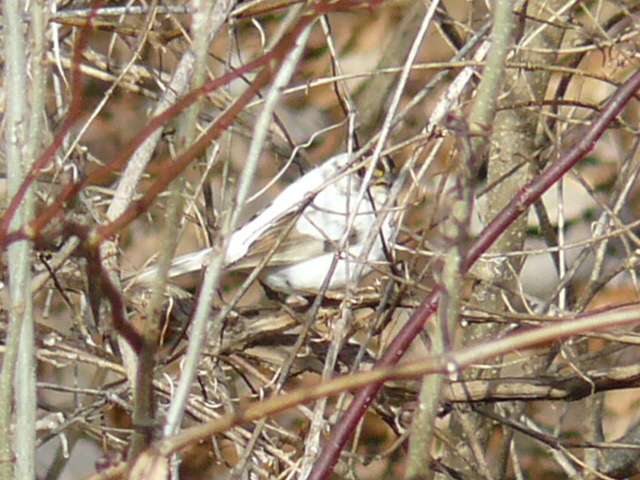
Not long into my walk, I encountered the usual sparrow flock, comprised of several dozen wintering White-throated Sparrows, a handful of Song Sparrows, and, on this day, a Field Sparrow, as well. Just as I was turning to move on, an unusually bright flash of feathers caught my eye on the back side of a vine-covered shrub. While my view was largely obscured, the bird in question had far too much white in its plumage to be anything ordinary. I spent the next half hour pursuing it around a dense thicket of thorn-covered wild rose and catbrier, never getting the photo that I was hoping for, but getting enough glimpses to know that I had stumbled upon a leucistic White-throat.
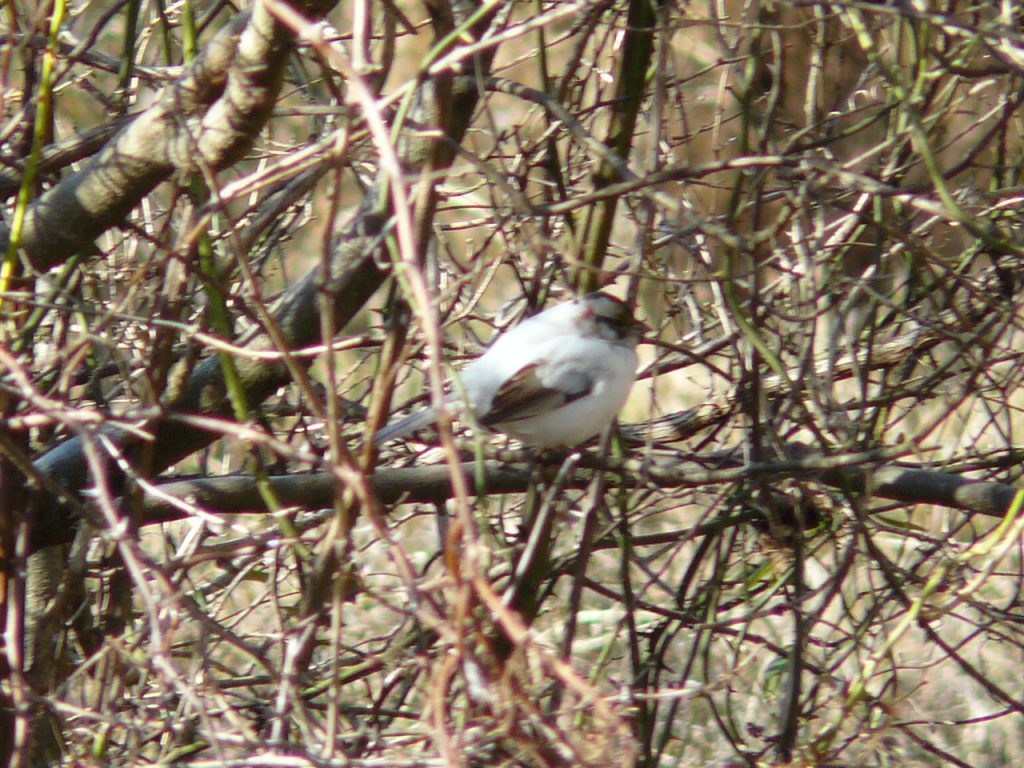
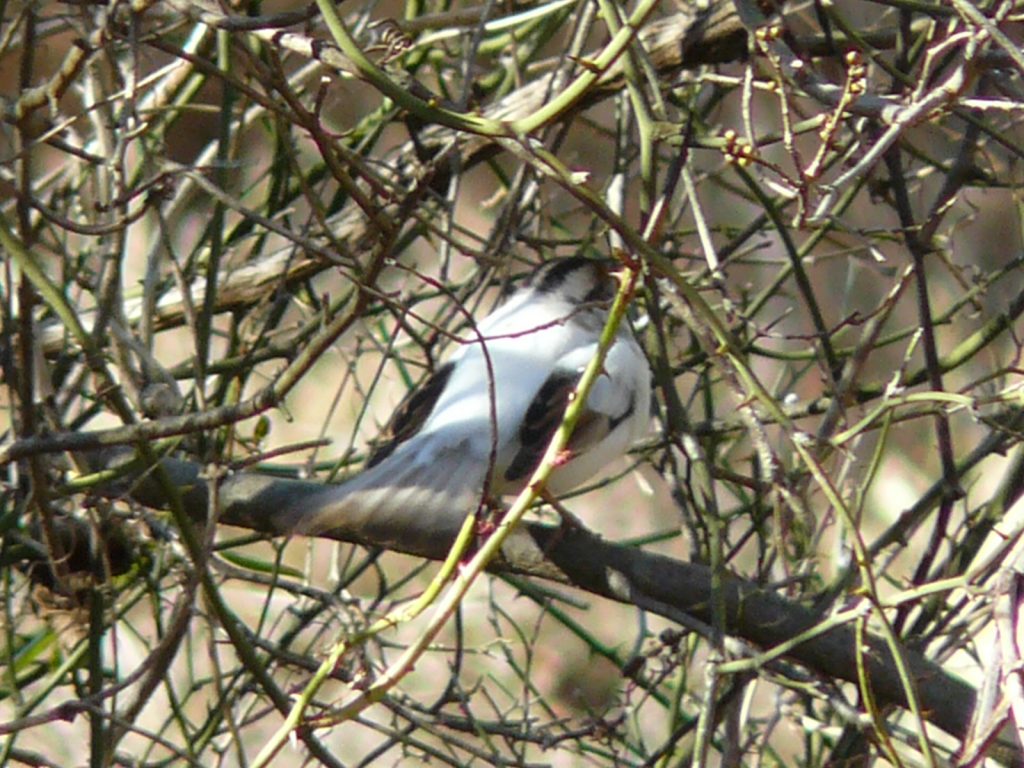
Often referred to as ‘partial albinos,’ leucistic organisms are not albino at all; rather, they possess a genetic condition that affects the pigmentation in their skin, fur, or, in the case of birds, feathers without affecting the eyes, beak, and feet; these have normal coloration, not pink. While relatively rare (Project FeederWatch data suggests that it occurs, to some degree, in roughly 1 of every 3000-4000 birds), leucism is more common than true albinism in nature. In my 40+ years of wildlife watching, I can recall encounters with six or seven leucistic birds, at least two deer, and several squirrels. Particularly striking are the larger birds with this genetic anomaly; I was once lucky enough to discover a leucistic Red-tailed Hawk during a road-side bird survey Pennsylvania, only to encounter it AGAIN at the same location two years later! Often, leucistic individuals appear piebald (blotchy), with some areas completely devoid of the usual pigment, but others appearing no different from the norm for that species. The sampling of leucistic American Robins below illustrates nearly the entire range of possibilities:
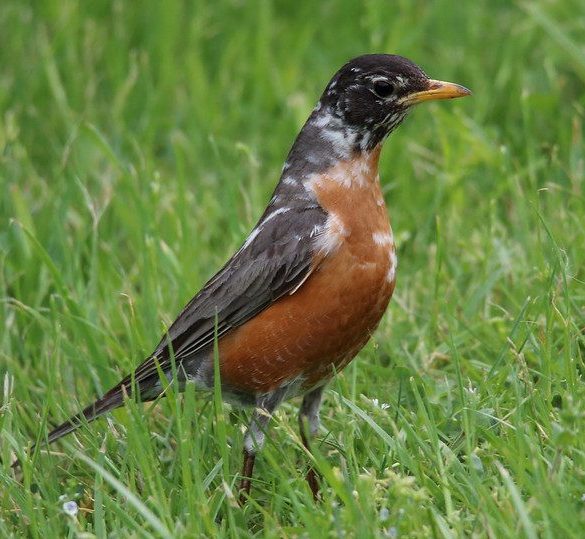
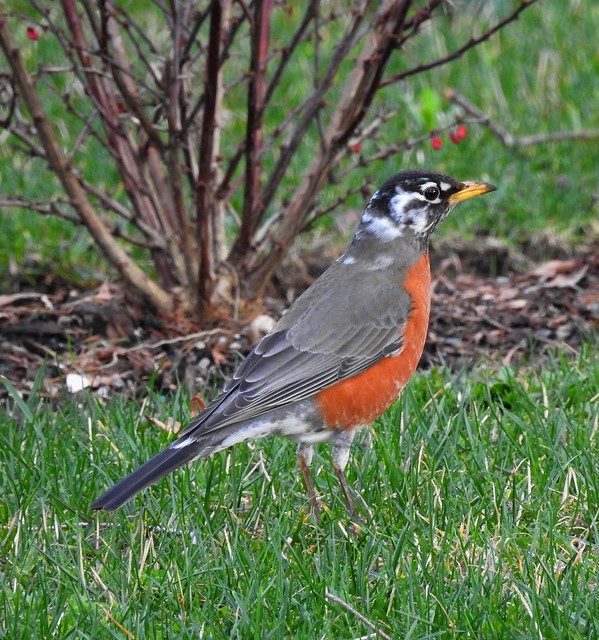
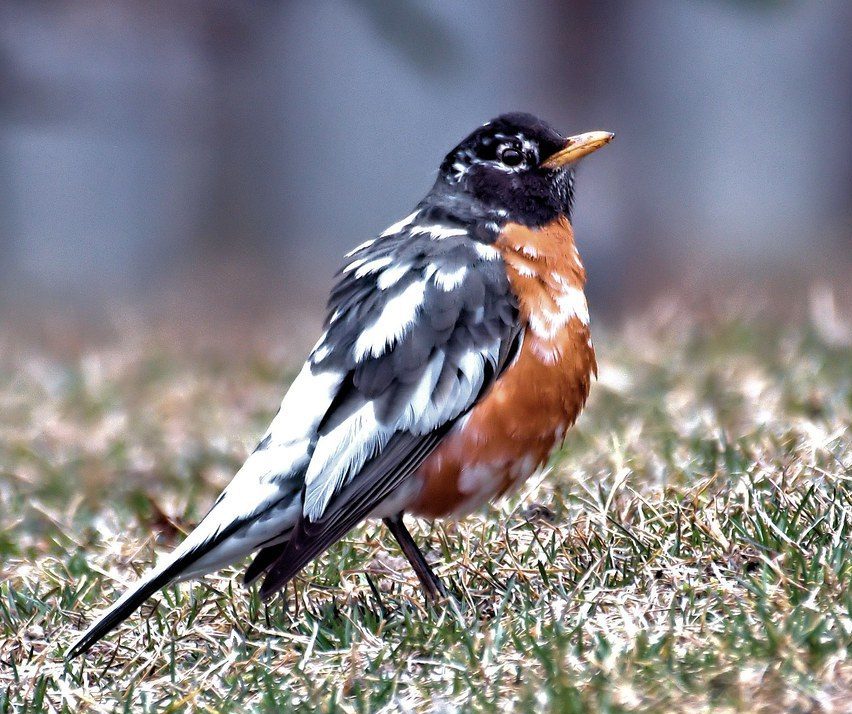
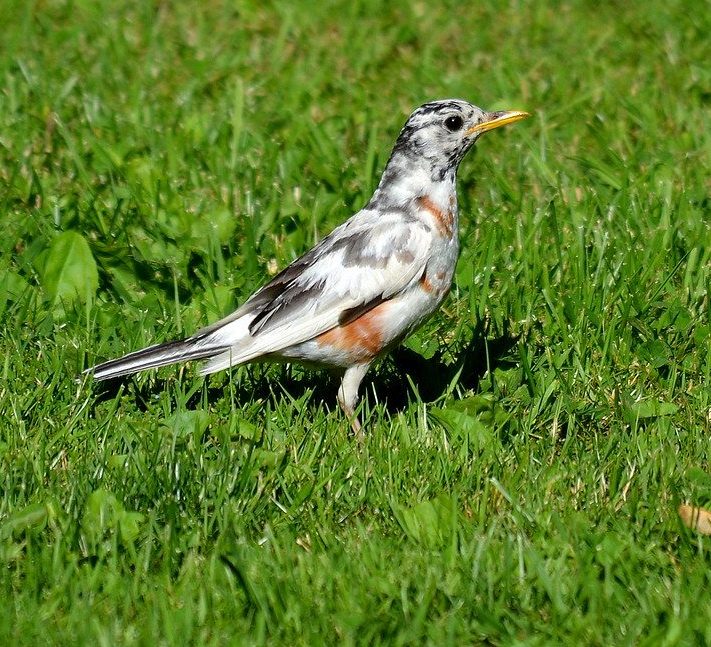
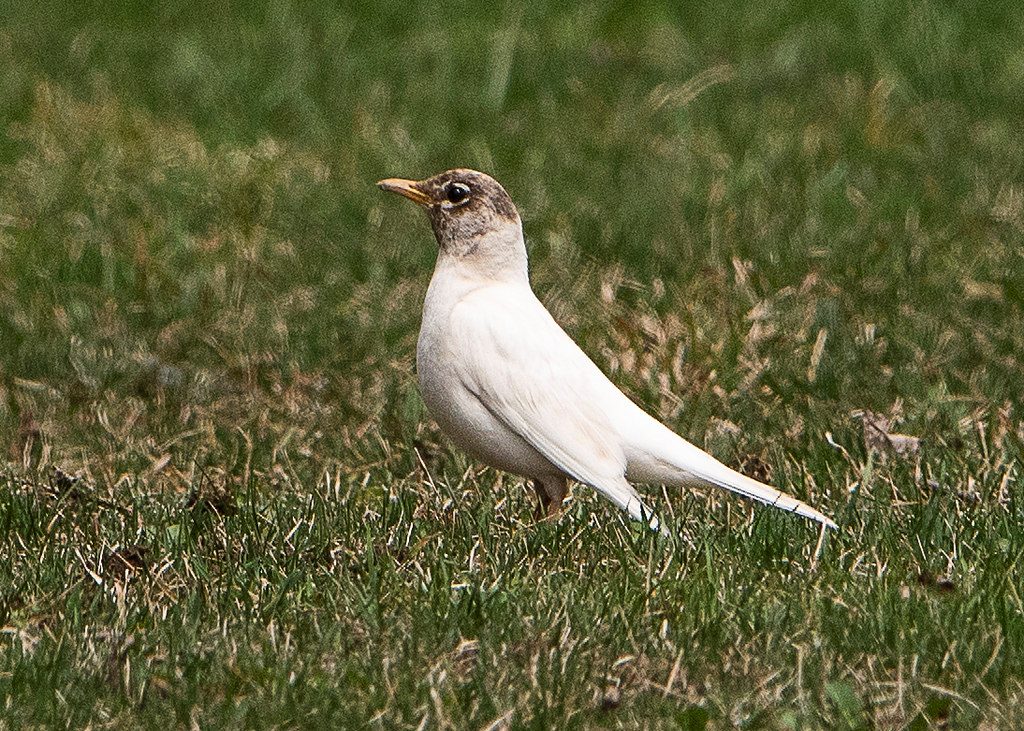
Sometimes the piebald pattern is much more ‘tidy’ in its patchiness, almost as if by design, as in the case of these two Common Grackles. A member of the blackbird family, the grackle (typical coloration on the left) is a subtly gorgeous bird, with iridescent plumage which often goes unnoticed until sunlight hits it. The two leucistic individuals to the right almost look like entirely different species, rather than aberrant colorations of the normal phenotype.
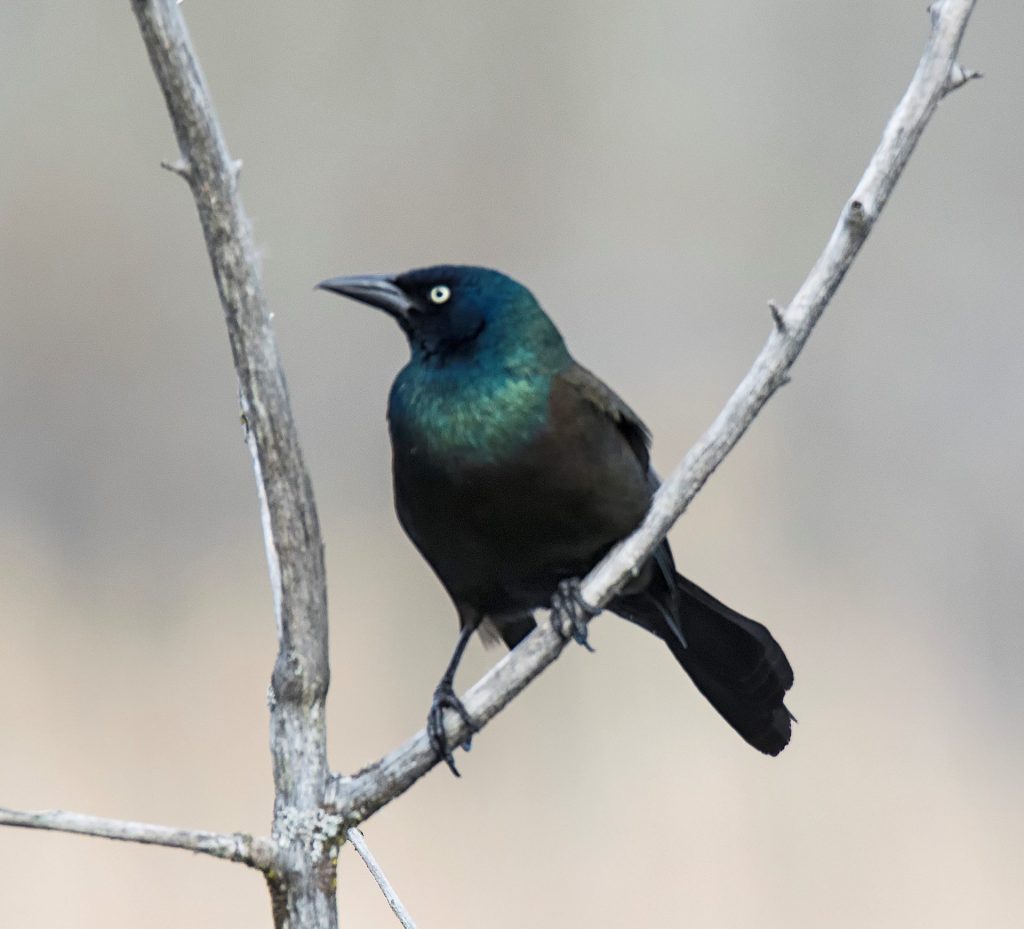
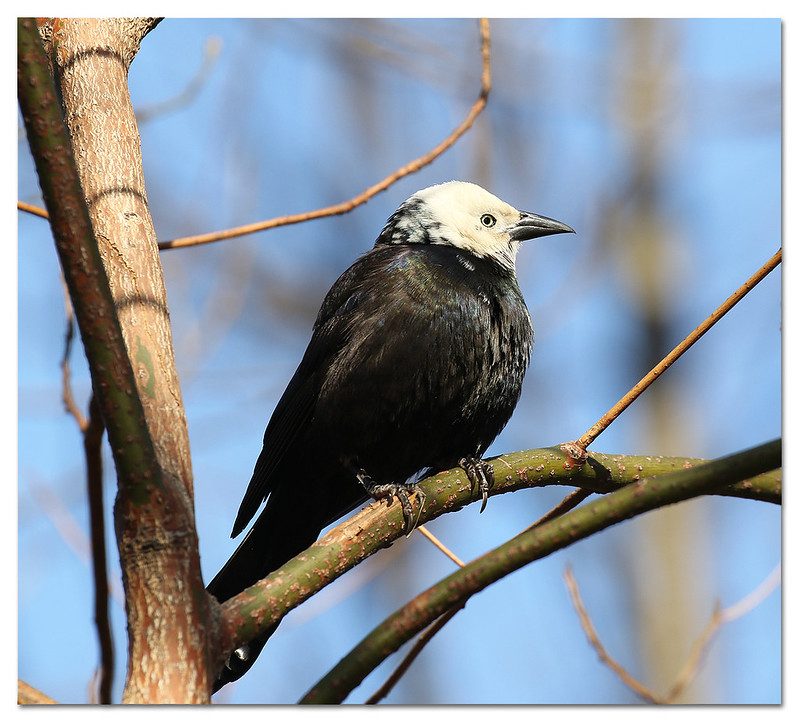
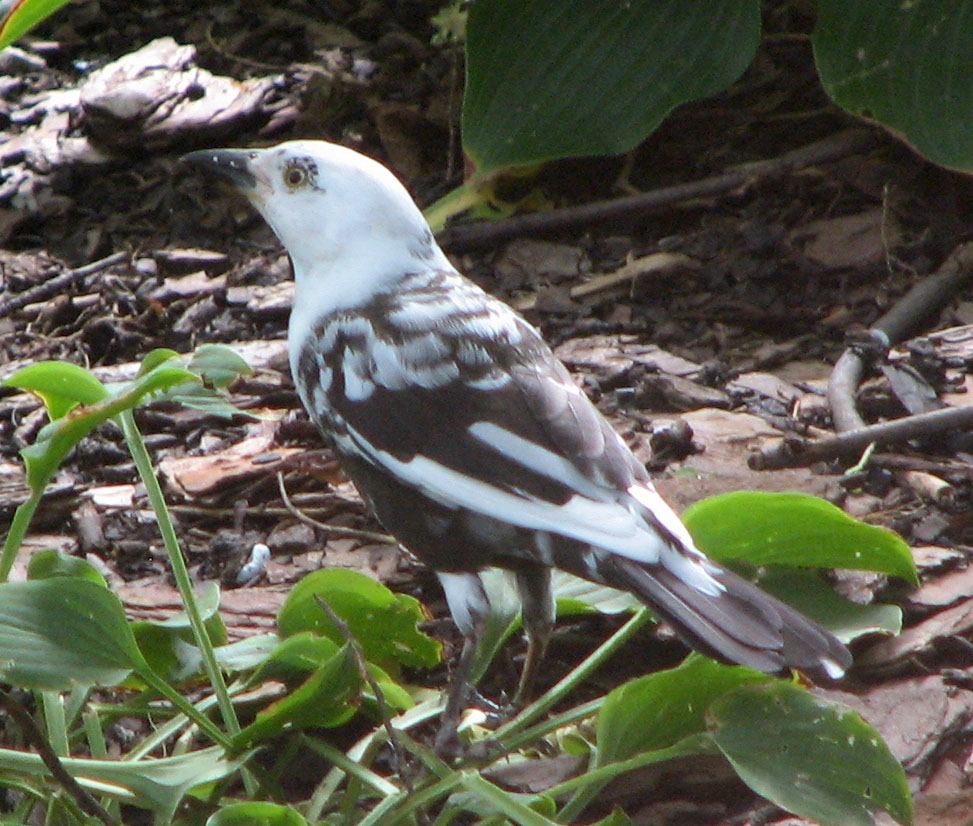
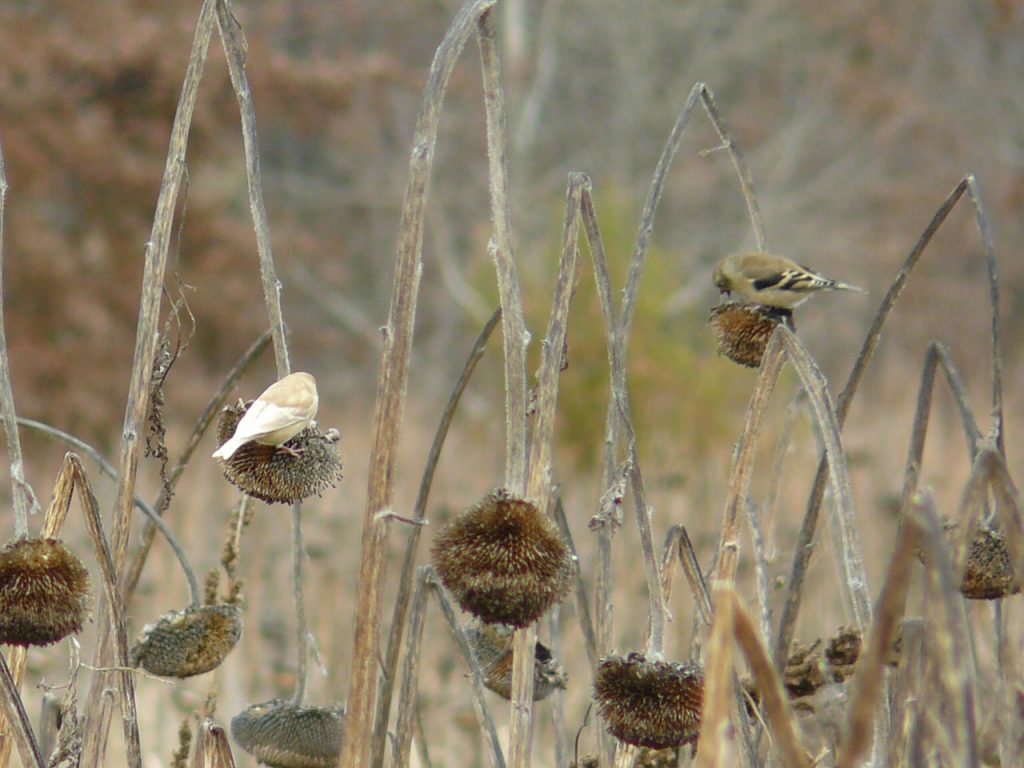 What struck me about my recent encounter with the White-throated Sparrow was that it was essentially the complete opposite of the last leucistic bird I had come across — an American Goldfinch that I had found amidst a large flock that was feasting in Irvine’s sunflower field in November of 2019. It’s shown here, along with a typical winter-plumaged goldfinch to the right. That bird, while drab all over, was entirely white only on the wings and tail (the primary feathers); last month’s White-throat had normal coloration only on its wings, head, and to an extent, its tail, on which could be found some reduced brown pigment. To its credit, this sparrow was even more wary of me than White-throats are in general. It really played hard-to-get when I was trying to photograph it, a sign that perhaps it will survive long-term, despite the fact that its stunning, but unfortunate, coloration makes it especially vulnerable to predation.
What struck me about my recent encounter with the White-throated Sparrow was that it was essentially the complete opposite of the last leucistic bird I had come across — an American Goldfinch that I had found amidst a large flock that was feasting in Irvine’s sunflower field in November of 2019. It’s shown here, along with a typical winter-plumaged goldfinch to the right. That bird, while drab all over, was entirely white only on the wings and tail (the primary feathers); last month’s White-throat had normal coloration only on its wings, head, and to an extent, its tail, on which could be found some reduced brown pigment. To its credit, this sparrow was even more wary of me than White-throats are in general. It really played hard-to-get when I was trying to photograph it, a sign that perhaps it will survive long-term, despite the fact that its stunning, but unfortunate, coloration makes it especially vulnerable to predation.
(2) One-antlered Deer:
About a week after encountering the unusual-looking sparrow, I was looking at White-throats under our backyard bird feeders shortly before dusk (most ground-feeding bird species, by 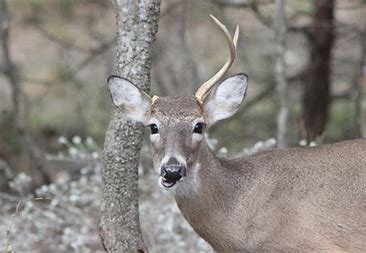 virtue of their ‘here-I-am, come-get-me’ feeding habits, tend to visit exposed feeders more frequently during times of low light–dawn, dusk, and overcast days, when they’re less obvious to predators from afar.) Suddenly, all of the sparrows, juncos, and cardinals beneath our feeders took flight as three White-tailed Deer–all 4-point or 6-point bucks–sauntered out of the woods and came to grab a few quick mouthfuls of seeds from the ground. Deer beneath our feeders are an increasingly common sight; what was not so usual was to see three antlered males together like this. Two of them boldly walked right up to the seed and starting eating; the third, however, hung back and seemed uneasy, readily yielding to the other two. Another glance revealed to me that this third buck was sporting only a single antler, on its left side, something I don’t know that I’ve ever come across before. However, if one was ever going to witness a mono-antlered deer, mid-winter would be the time.
virtue of their ‘here-I-am, come-get-me’ feeding habits, tend to visit exposed feeders more frequently during times of low light–dawn, dusk, and overcast days, when they’re less obvious to predators from afar.) Suddenly, all of the sparrows, juncos, and cardinals beneath our feeders took flight as three White-tailed Deer–all 4-point or 6-point bucks–sauntered out of the woods and came to grab a few quick mouthfuls of seeds from the ground. Deer beneath our feeders are an increasingly common sight; what was not so usual was to see three antlered males together like this. Two of them boldly walked right up to the seed and starting eating; the third, however, hung back and seemed uneasy, readily yielding to the other two. Another glance revealed to me that this third buck was sporting only a single antler, on its left side, something I don’t know that I’ve ever come across before. However, if one was ever going to witness a mono-antlered deer, mid-winter would be the time.
Antler growth is triggered by photoperiod, not temperature, as was once believed. As the amount of daylight slowly dwindles over the summer and into early fall, testosterone levels rise and antlers–new bone growth, covered with a velvety skin–begin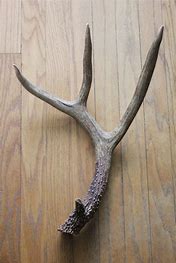 to grow rapidly. In fact, antlers can grow at a rate exceeding 1/4 inch per day, making them the fastest growing bone of which we’re aware. A buck’s two antlers grow independently of one another and, thus, don’t always have the same number of points. As autumn progresses, the ‘velvet’ begins to fall off (hastened by bucks rubbing it on tree trunks, in response to its itchiness) and the antlers begin to harden in preparation for their real purpose–establishing dominance and competing for mates. During the November ‘rut,’ bucks will spar over does, although much of the competition is resolved with just threats, rather than actual battles. In general, larger racks are a sign of good health and nutrition, more than age; hence, the more impressive, stronger appearing males are the ones that will be most likely to mate and pass on their genes.
to grow rapidly. In fact, antlers can grow at a rate exceeding 1/4 inch per day, making them the fastest growing bone of which we’re aware. A buck’s two antlers grow independently of one another and, thus, don’t always have the same number of points. As autumn progresses, the ‘velvet’ begins to fall off (hastened by bucks rubbing it on tree trunks, in response to its itchiness) and the antlers begin to harden in preparation for their real purpose–establishing dominance and competing for mates. During the November ‘rut,’ bucks will spar over does, although much of the competition is resolved with just threats, rather than actual battles. In general, larger racks are a sign of good health and nutrition, more than age; hence, the more impressive, stronger appearing males are the ones that will be most likely to mate and pass on their genes.
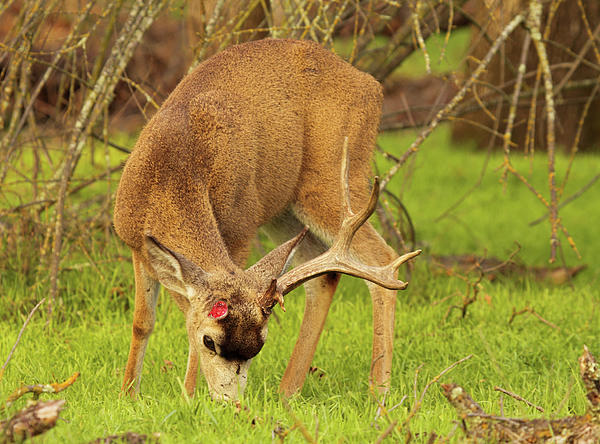 After the breeding season, testosterone levels drop notably, and bucks begin to shed their antlers. In Maryland, January and February are typically when ‘antler drops’ occur. The two antlers do not drop simultaneously, just as they did not grow in synchrony, but there’s generally only a brief period of several days in between drops. The third buck in my backyard in late January just happened to be in between his two antler drops. As do all good things in the circle of life, antlers serve a useful purpose after shedding, as well. Once dropped, they get gnawed upon by squirrels, mice, and other rodents, who benefit from the calcium and minerals they ingest and also file down their rapidly growing incisors. This is why one rarely encounters antlers on the ground in the wild; by spring they’ve often been pretty much devoured by other critters! And it is only a matter of several months before the annual process starts all over and each buck begins to grow a new set of antlers.
After the breeding season, testosterone levels drop notably, and bucks begin to shed their antlers. In Maryland, January and February are typically when ‘antler drops’ occur. The two antlers do not drop simultaneously, just as they did not grow in synchrony, but there’s generally only a brief period of several days in between drops. The third buck in my backyard in late January just happened to be in between his two antler drops. As do all good things in the circle of life, antlers serve a useful purpose after shedding, as well. Once dropped, they get gnawed upon by squirrels, mice, and other rodents, who benefit from the calcium and minerals they ingest and also file down their rapidly growing incisors. This is why one rarely encounters antlers on the ground in the wild; by spring they’ve often been pretty much devoured by other critters! And it is only a matter of several months before the annual process starts all over and each buck begins to grow a new set of antlers.
(3) A Tailless Cardinal
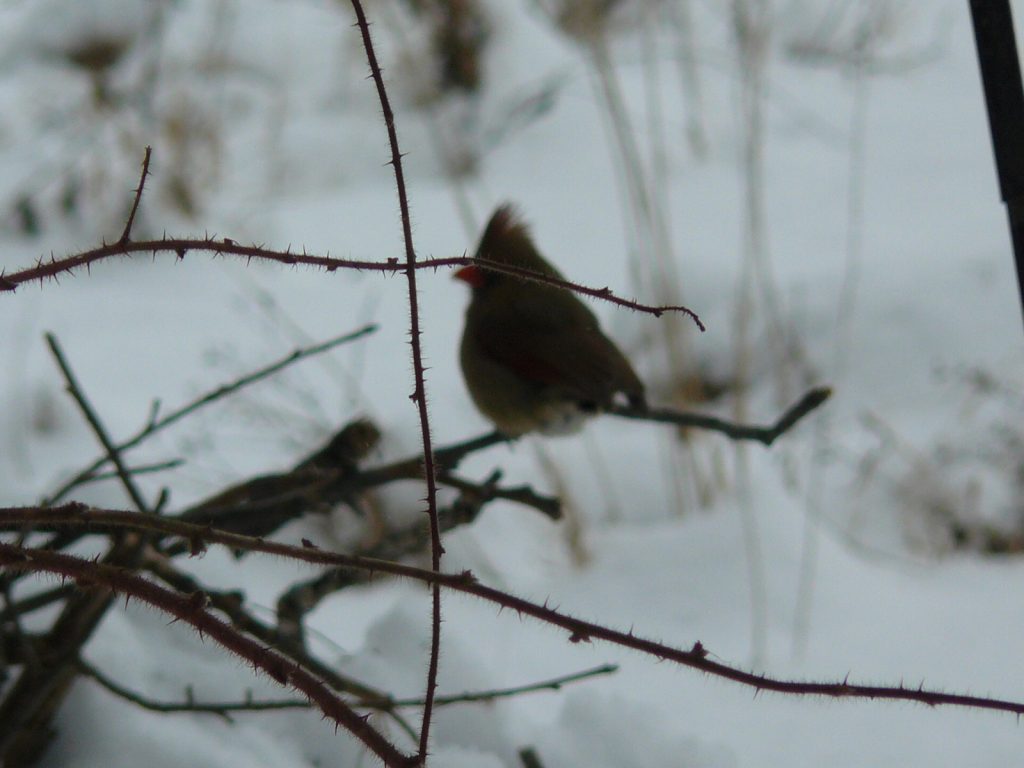 On Thursday and Friday mornings during the colder half of the year, four dedicated Irvine volunteers sit quietly in our two blinds and record the species and number of individual birds that visit our two feeding stations. The data that they collect is submitted to the Cornell Lab of Ornithology, as part of the continent-wide citizen science project FeederWatch and used to track avian population trends, migrations, and food-related irruptions each winter. This year, with COVID-restrictions impacting our usual volunteer force, my predecessor, Rob Mardiney, and I have been helping out with the weekly monitoring. Just yesterday, I was heading out to the far blind, at the edge of the Pollinator Meadow, when three times along that short walk I saw reddish-brown feathers sitting atop the snow. ‘Looks like somebody had a female cardinal for dinner,’ I thought to myself. A mere twenty minutes later, the feeders were hopping. The arrival of several recent cold fronts and snow cover of close to 5 inches had made finding natural food sources challenging, and birds eagerly came to the feeders, despite my sitting only ten feet away. In an hour, I had tallied over 50 birds of a dozen species, including an unprecedented 15 Northern Cardinals at one time.
On Thursday and Friday mornings during the colder half of the year, four dedicated Irvine volunteers sit quietly in our two blinds and record the species and number of individual birds that visit our two feeding stations. The data that they collect is submitted to the Cornell Lab of Ornithology, as part of the continent-wide citizen science project FeederWatch and used to track avian population trends, migrations, and food-related irruptions each winter. This year, with COVID-restrictions impacting our usual volunteer force, my predecessor, Rob Mardiney, and I have been helping out with the weekly monitoring. Just yesterday, I was heading out to the far blind, at the edge of the Pollinator Meadow, when three times along that short walk I saw reddish-brown feathers sitting atop the snow. ‘Looks like somebody had a female cardinal for dinner,’ I thought to myself. A mere twenty minutes later, the feeders were hopping. The arrival of several recent cold fronts and snow cover of close to 5 inches had made finding natural food sources challenging, and birds eagerly came to the feeders, despite my sitting only ten feet away. In an hour, I had tallied over 50 birds of a dozen species, including an unprecedented 15 Northern Cardinals at one time.
Among them was an oddball female, completely lacking a tail! She seemed clumsy, 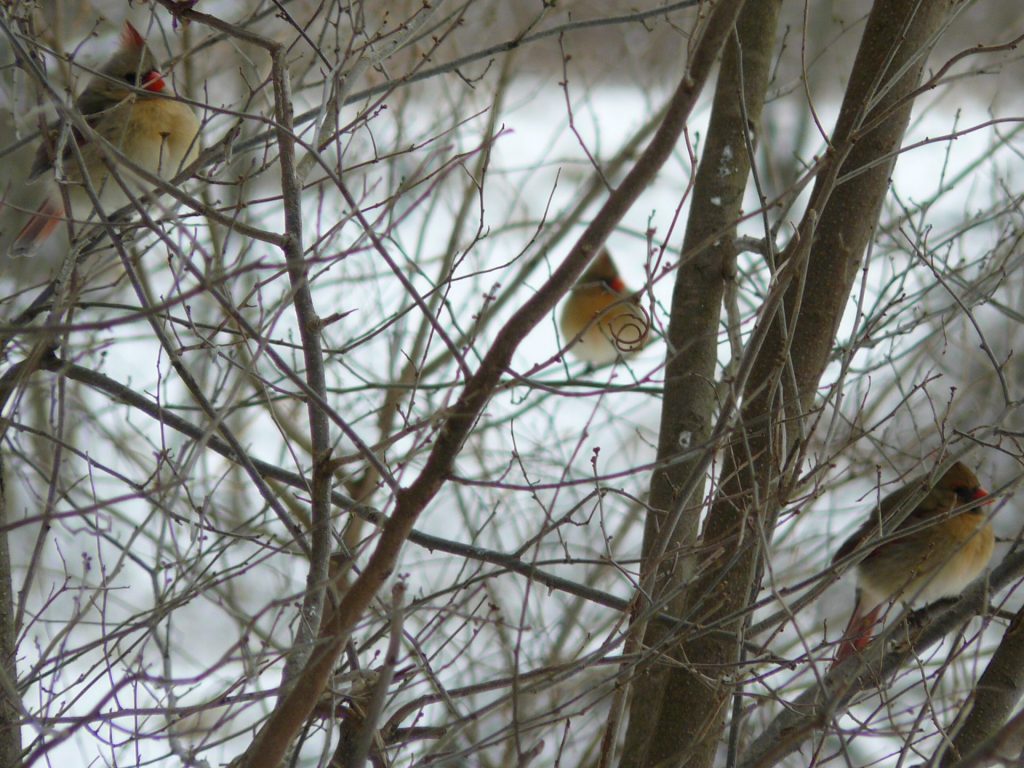 occasionally teetering on the branches on which she perched, and also exceedingly shy. She spent most of her time on the back side of a bush, away from the hubbub at the feeding station, but flew in from time to time, grabbed a seed, and immediately took it elsewhere to eat. There were several times when another bird landed next to her, and she skittishly bolted to a different branch, as if startled and afraid. Again, this type of behavior made it difficult for me to get a photo, for she never sat still for long; all I have to show for the encounter is two blurry images. (She’s set back and in the middle of this picture; notice her posture and complete lack of tail feathers–a.k.a. retrices–relative to her two associates.)
occasionally teetering on the branches on which she perched, and also exceedingly shy. She spent most of her time on the back side of a bush, away from the hubbub at the feeding station, but flew in from time to time, grabbed a seed, and immediately took it elsewhere to eat. There were several times when another bird landed next to her, and she skittishly bolted to a different branch, as if startled and afraid. Again, this type of behavior made it difficult for me to get a photo, for she never sat still for long; all I have to show for the encounter is two blurry images. (She’s set back and in the middle of this picture; notice her posture and complete lack of tail feathers–a.k.a. retrices–relative to her two associates.)
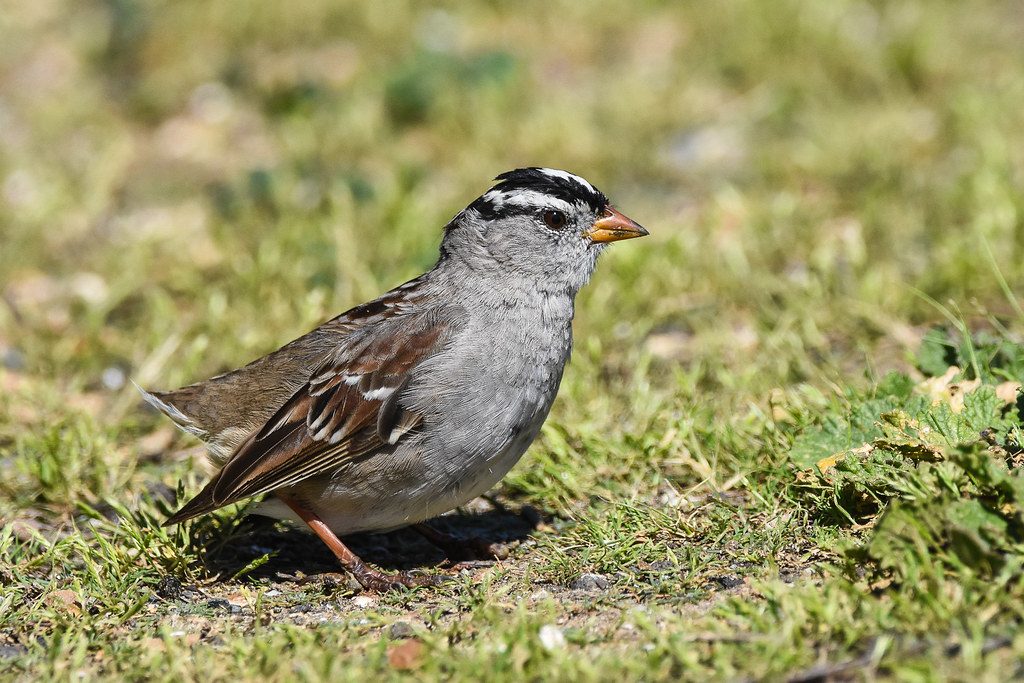 But, again, her jumpiness makes sense, in light of her competitive handicap, and shows that she realizes she has to be extra cautious. While it is typical for very young birds to pass through a brief period of time in which flight feathers have come in but retrices aren’t yet developed, tailless adult birds are far less common. The only time it might possibly be seen in an adult cardinal is during the period of their annual molt. Cardinals, in fact, are one of the bird species that exhibit the most extreme body molts–and occasionally lose all head feathers at once!–however, their molt generally occurs early in the fall, not long after the nesting season comes to a close. A tailless cardinal in mid-winter would not be a molting bird.
But, again, her jumpiness makes sense, in light of her competitive handicap, and shows that she realizes she has to be extra cautious. While it is typical for very young birds to pass through a brief period of time in which flight feathers have come in but retrices aren’t yet developed, tailless adult birds are far less common. The only time it might possibly be seen in an adult cardinal is during the period of their annual molt. Cardinals, in fact, are one of the bird species that exhibit the most extreme body molts–and occasionally lose all head feathers at once!–however, their molt generally occurs early in the fall, not long after the nesting season comes to a close. A tailless cardinal in mid-winter would not be a molting bird.
The most likely explanation for a tailless adult bird outside of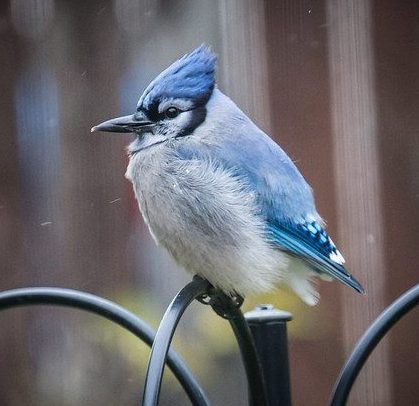 molting season is, of course, a close call with a predator. Given this female cardinal’s extremely skittish behavior and the reddish feathers I found on the ground less than fifty yards away, one doesn’t have to be Sherlock Holmes to put two and two together in this case. Most likely, she had a run in with a swift-flying accipiter (Cooper’s or Sharp-shinned Hawk) or with one of Irvine’s red foxes over the previous few days, had narrowly escaped, and was increasingly nervous and vigilant as a result. I really hope she makes it, although I’m skeptical. While all of the other birds were eating voraciously, she was able to nab and consume maybe five seeds in a half-hour’s time. And, her flight was awkward, with limited maneuverability. Unlike many of nature’s mysteries, however, I may actually get to find out how this one ends. Since Cardinals are one of Maryland’s year-round resident species and do not migrate at all, if she makes it, I may well run into her again. I’ll certainly be keeping my eyes out at our next FeederWatch session. Now whether I’ll recognize her is another story. If her retrices were merely damaged/broken off, but not pulled out by the root, she may not grow a new tail until next fall’s molt; however if the feather shafts also came out, which would be my guess, her tail could regenerate much sooner and I’d never know it was her.
molting season is, of course, a close call with a predator. Given this female cardinal’s extremely skittish behavior and the reddish feathers I found on the ground less than fifty yards away, one doesn’t have to be Sherlock Holmes to put two and two together in this case. Most likely, she had a run in with a swift-flying accipiter (Cooper’s or Sharp-shinned Hawk) or with one of Irvine’s red foxes over the previous few days, had narrowly escaped, and was increasingly nervous and vigilant as a result. I really hope she makes it, although I’m skeptical. While all of the other birds were eating voraciously, she was able to nab and consume maybe five seeds in a half-hour’s time. And, her flight was awkward, with limited maneuverability. Unlike many of nature’s mysteries, however, I may actually get to find out how this one ends. Since Cardinals are one of Maryland’s year-round resident species and do not migrate at all, if she makes it, I may well run into her again. I’ll certainly be keeping my eyes out at our next FeederWatch session. Now whether I’ll recognize her is another story. If her retrices were merely damaged/broken off, but not pulled out by the root, she may not grow a new tail until next fall’s molt; however if the feather shafts also came out, which would be my guess, her tail could regenerate much sooner and I’d never know it was her.
All three of these encounters caught me by surprise and piqued my curiosity to understand more about these unusual, but natural, anomalies of pigmentation, antler condition, and plumage. nature, of course, is full of surprises. As These three instances reminded me, one doesn’t have to go to exotic places or in search of rare species to stumble upon unusual finds which can lead to new appreciation and enhanced knowledge about our natural world. immense satisfaction and wonderment can be found in one’s own backyard; just put down the checklist and watch! –BR
